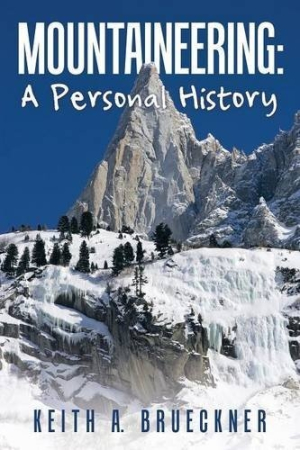Mountaineering: A Personal History
This quiet, everyman approach to mountaineering is accessible and filled with grand scenes.
A meticulous, posthumous memoir from Keith A. Brueckner charts half a century of exploring mountains in North America and Europe. Through journal entries and descriptions of both attempted and successful climbs, a story of learning to rise to new challenges unfolds against scenic grandeur. Mountaineering: A Personal History is a portrait of one man’s enduring fascination with the sport.
Brueckner’s interest in mountaineering was sparked in the 1930s during a family trip to the Canadian Rockies. After a brief introduction, the book features early climbs that display inexperience and plentiful spirit, midcentury excursions, forays to Chamonix in the 1970s, and later ascents with increasing dexterity. Including the Sierra, Half Dome, the French Alps, the Dolomites, and other locales, Brueckner’s solo and guided climbs emphasize technical details, training, and niche facts that provide fellow mountaineers with a glimpse of an earlier era’s limitations, as well as a clear sense for how the sport has evolved.
The book is organized through a painstaking list of climbs, with few digressions in between. The approach keeps the work narrowly focused, but it often turns repetitive. Many paragraphs begin to echo each other in the mundane, necessary details of a climb, from early morning start times to descriptions of terrain, equipment, and physical maneuvers; the last chapter in particular is an assemblage of several trips. Brueckner himself remains elusive. Minimal connections to other aspects in his life suggest a careful narrator who favors recording impressions and turning the lens outward.
When the writing does veer from logistics, a naturalist’s eye for color and sensitivity to changes in the environment reveal breathtaking landscapes. Especially well-drawn scenes include passages on the Sierra. Such moments contain a cool elegance; they make a strong case for venturing into the wilderness. Other noteworthy sections portray climbs with various guides and colleagues. These offer a vivid perspective on the ins and outs of working with someone in unpredictable circumstances. The most splendid section, written in the present tense, serves as a response to a friend’s question: “Why do you climb?” It’s here, at last, that the writing achieves a crisp, invigorating immediacy.
If a restrained humility sometimes results in dry sections, it’s a fitting stance for a book that regards mountaineering as a lifelong discipline rather than as a competition for the elite. Brueckner’s account is a refreshing reminder that numerous climbers at all levels of experience have persevered. In a genre that is often eclipsed by dramas on Everest, this quieter, everyman appreciation for mountaineering is an accessible alternative.
Reviewed by
Karen Rigby
Disclosure: This article is not an endorsement, but a review. The publisher of this book provided free copies of the book and paid a small fee to have their book reviewed by a professional reviewer. Foreword Reviews and Clarion Reviews make no guarantee that the publisher will receive a positive review. Foreword Magazine, Inc. is disclosing this in accordance with the Federal Trade Commission’s 16 CFR, Part 255.

